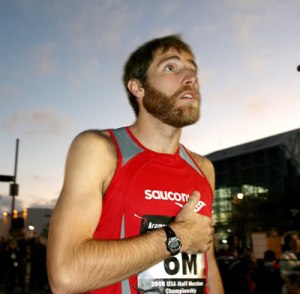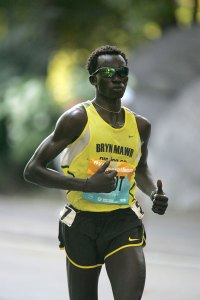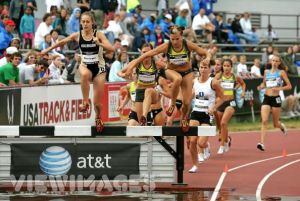“It’s dark out; I’m not getting up yet”. He walked into the bathroom, took a prodigious piss, and then plopped back into bed. Laying in bed images of the run he would do in a few hours fleetingly crossed his mind—he could hear the wind bellowing outside. It’s going to be cold he mused as he fell back into the rhythm of sleep.
Light shone in the room—the day is beginning. A truck’s obnoxious reverse beeping could be heard in the distance. “It has to be past 7:00am the construction workers are out already.” Michael stiffly got out of bed ambled to the window pulled open the blind and acutely judged the attire of the students walking about the campus. “It’s nasty out. They all have the hoods of their jackets up and are walking with an extra brisk stride to match the weather. I can even see their breath.” This is how all days begin and the beginning of each day carries the same routine. Routine is what makes the hours fly by. Runners thrive on routine. Without routine runners question every aspect of their day with the insecure scrutiny of a middle school cheerleader.
Michael dressed accordingly and headed to the kitchen to have oatmeal and a glass of OJ before his run. While eating his oatmeal he sits at his laptop and pours over numerous running web pages. A half an hour after getting out of bed he is out the door. He adroitly maneuvers around the streets taking his preferred route through the graveyard to avoid a busy road with unfriendly and overweight drivers who are quick to scream obscenities at him inside their mobile bubble of safety. “I must look so funny to them skin and bones at 5’10” and weighing 135 pounds adorned in spandex and a technical top, made with as much thought as the bubbles they fly through the roads with, that keeps me warm at 0 degrees Fahrenheit.” Curly blonde hair peaks out from under his hat and bright blue eyes shine with excitement as they view the world from their favorite mode of vantage. He has a bravado when running that disappears as soon as he is done. When he is running he is powerful beyond his size—he is powerful because of his size. He is powerful because the engine that he built up inside of him. He is powerful because he is free to explore anything.
“I too fly through the roads. I fly through the roads the way man was intended. I own the roads—they are simply unwanted trespassers.” His anxiety decreases as the travels into the rural roads of town. Here he can zone out and just flow. He can feel the ground with each step. He can hear the streams, birds, wind, and if God were to ever choose to speak to him, he knows it would be on these rural roads meditating as he glides at 6:30 pace.
______________________
Running is one of the only sports that a semi-talented athlete can attain greatness, look at Brian Sell—he didn’t even break 10:00 in the 3200m in high school now he is an Olympic qualifier in the marathon. He is a hero to distance runners. The American dream, the spirit of America, is more alive in distance running than in America’s hierarchy itself. America grants the illusion that anyone can attain greatness. In reality those born into money are often those who, surprise, attain “greatness.” In distance running those with genetic greatness don’t necessarily come out on top. You have to work terrifyingly hard to come out on top and many talented people are afraid to do that. Why should they work hard, they don’t need to work hard to succeed. This may work throughout high school. This may even work throughout college when they have a team and guidance from a coach. However, many talented athletes quit after college because they no longer see the need to train and compete. These individuals just get sucked up into the working world. Those who are not talented often fall off too. They work terrifyingly hard; however, they do not see the benefits they deserve and they too often quit. Those who do not will see vast improvements but not see the times that raise brows. In distance running, the semi-talented athlete often attains greatness.
The semi-talented athlete fails, repeatedly. However, these failures are different from the athlete with little talent these failures are close failures. Close failures drive the athlete to work that much harder to succeed next time. Next time is often a close failure as well. A semi-talented high school athlete will choose to run in college because they never made it to their state meet, or they never attained all-state recognition. The glory was not met so the journey must continue. In college the athlete may never qualify for a national championship or never attain All-American status. Therefore, the journey must continue.
Michael was a semi-talented athlete who never qualified for states in high school, and Michael never qualified for nationals in college. In both cases he was tantalizingly close. Michael’s tantalizing failures were the variety that drives the slightly manic distance runner into brief depression in which everything about one’s life is questioned. Now, a Masters student at the state university, he continues his journey. Michael is seeking the glory which has always snubbed him in the past. Now, the bar is set higher. The natural progression through competition stages elevates the bar. The goal is no longer states or nationals. Now, the goal is the 2012 Olympic trials marathon. First, however, he is training for a 2008 half marathon. The furthest race he has ever run after all is 10k.





